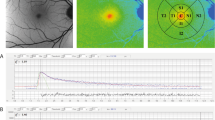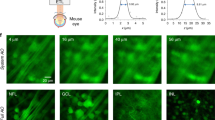Abstract
Multiphoton excitation fluorescence microscopy (MPM) can image certain molecular processes in vivo. In the eye, fluorescent retinyl esters in subcellular structures called retinosomes mediate regeneration of the visual chromophore, 11-cis-retinal, by the visual cycle. But harmful fluorescent condensation products of retinoids also occur in the retina. We report that in wild-type mice, excitation with a wavelength of ∼730 nm identified retinosomes in the retinal pigment epithelium, and excitation with a wavelength of ∼910 nm revealed at least one additional retinal fluorophore. The latter fluorescence was absent in eyes of genetically modified mice lacking a functional visual cycle, but accentuated in eyes of older wild-type mice and mice with defective clearance of all-trans-retinal, an intermediate in the visual cycle. MPM, a noninvasive imaging modality that facilitates concurrent monitoring of retinosomes along with potentially harmful products in aging eyes, has the potential to detect early molecular changes due to age-related macular degeneration and other defects in retinoid metabolism.
This is a preview of subscription content, access via your institution
Access options
Subscribe to this journal
Receive 12 print issues and online access
$209.00 per year
only $17.42 per issue
Buy this article
- Purchase on Springer Link
- Instant access to full article PDF
Prices may be subject to local taxes which are calculated during checkout





Similar content being viewed by others
References
Schenke-Layland, K., Riemann, I., Damour, O., Stock, U.A. & Konig, K. Two-photon microscopes and in vivo multiphoton tomographs—powerful diagnostic tools for tissue engineering and drug delivery. Adv. Drug Deliv. Rev. 58, 878–896 (2006).
Zhang, E.Z., Laufer, J.G., Pedley, R.B. & Beard, P.C. In vivo high-resolution 3D photoacoustic imaging of superficial vascular anatomy. Phys. Med. Biol. 54, 1035–1046 (2009).
Kim, J.S. et al. Imaging of transient structures using nanosecond in situ TEM. Science 321, 1472–1475 (2008).
Shoham, D. et al. Imaging cortical dynamics at high spatial and temporal resolution with novel blue voltage-sensitive dyes. Neuron 24, 791–802 (1999).
Hell, S.W. Far-field optical nanoscopy. Science 316, 1153–1158 (2007).
DaCosta, R.S., Wilson, B.C. & Marcon, N.E. Optical techniques for the endoscopic detection of dysplastic colonic lesions. Curr. Opin. Gastroenterol. 21, 70–79 (2005).
Evgenov, N.V., Medarova, Z., Dai, G., Bonner-Weir, S. & Moore, A. In vivo imaging of islet transplantation. Nat. Med. 12, 144–148 (2006).
Piston, D.W. Imaging living cells and tissues by two-photon excitation microscopy. Trends Cell Biol. 9, 66–69 (1999).
Imanishi, Y., Lodowski, K.H. & Koutalos, Y. Two-photon microscopy: shedding light on the chemistry of vision. Biochemistry 46, 9674–9684 (2007).
Denk, W., Strickler, J.H. & Webb, W.W. Two-photon laser scanning fluorescence microscopy. Science 248, 73–76 (1990).
Xu, C., Zipfel, W., Shear, J.B., Williams, R.M. & Webb, W.W. Multiphoton fluorescence excitation: new spectral windows for biological nonlinear microscopy. Proc. Natl. Acad. Sci. USA 93, 10763–10768 (1996).
Imanishi, Y., Sun, W., Maeda, T., Maeda, A. & Palczewski, K. Retinyl ester homeostasis in the adipose differentiation-related protein–deficient retina. J. Biol. Chem. 283, 25091–25102 (2008).
Imanishi, Y., Batten, M.L., Piston, D.W., Baehr, W. & Palczewski, K. Noninvasive two-photon imaging reveals retinyl ester storage structures in the eye. J. Cell Biol. 164, 373–383 (2004).
Imanishi, Y., Gerke, V. & Palczewski, K. Retinosomes: new insights into intracellular managing of hydrophobic substances in lipid bodies. J. Cell Biol. 166, 447–453 (2004).
von Lintig, J., Kiser, P.D., Golczak, M. & Palczewski, K. The biochemical and structural basis for trans-to-cis isomerization of retinoids in the chemistry of vision. Trends Biochem. Sci. 35, 400–410 (2010).
Sparrow, J.R., Wu, Y., Kim, C.Y. & Zhou, J. Phospholipid meets all-trans-retinal: the making of RPE bisretinoids. J. Lipid Res. 51, 247–261 (2010).
Maeda, A., Maeda, T., Golczak, M. & Palczewski, K. Retinopathy in mice induced by disrupted all-trans-retinal clearance. J. Biol. Chem. 283, 26684–26693 (2008).
Maeda, A. et al. Involvement of all-trans-retinal in acute light-induced retinopathy of mice. J. Biol. Chem. 284, 15173–15183 (2009).
Zhou, J., Jang, Y.P., Kim, S.R. & Sparrow, J.R. Complement activation by photooxidation products of A2E, a lipofuscin constituent of the retinal pigment epithelium. Proc. Natl. Acad. Sci. USA 103, 16182–16187 (2006).
Zhou, J., Kim, S.R., Westlund, B.S. & Sparrow, J.R. Complement activation by bisretinoid constituents of RPE lipofuscin. Invest. Ophthalmol. Vis. Sci. 50, 1392–1399 (2009).
Sparrow, J.R. et al. Involvement of oxidative mechanisms in blue-light–induced damage to A2E-laden RPE. Invest. Ophthalmol. Vis. Sci. 43, 1222–1227 (2002).
Katz, M.L. & Redmond, T.M. Effect of Rpe65 knockout on accumulation of lipofuscin fluorophores in the retinal pigment epithelium. Invest. Ophthalmol. Vis. Sci. 42, 3023–3030 (2001).
Van Hooser, J.P. et al. Rapid restoration of visual pigment and function with oral retinoid in a mouse model of childhood blindness. Proc. Natl. Acad. Sci. USA 97, 8623–8628 (2000).
Van Hooser, J.P. et al. Recovery of visual functions in a mouse model of Leber congenital amaurosis. J. Biol. Chem. 277, 19173–19182 (2002).
Drabent, R., Bryl, K. & Olszewska, T. A water environment forces retinyl palmitate to create self-organized structures in binary solvents. J. Fluoresc. 7, 347–355 (1997).
Maeda, A., Golczak, M., Maeda, T. & Palczewski, K. Limited roles of Rdh8, Rdh12, and Abca4 in all-trans-retinal clearance in mouse retina. Invest. Ophthalmol. Vis. Sci. 50, 5435–5443 (2009).
Maeda, T., Maeda, A., Leahy, P., Saperstein, D.A. & Palczewski, K. Effects of long-term administration of 9-cis-retinyl acetate on visual function in mice. Invest. Ophthalmol. Vis. Sci. 50, 322–333 (2009).
Sparrow, J.R., Parish, C.A., Hashimoto, M. & Nakanishi, K. A2E, a lipofuscin fluorophore, in human retinal pigmented epithelial cells in culture. Invest. Ophthalmol. Vis. Sci. 40, 2988–2995 (1999).
Kevany, B.M. & Palczewski, K. Phagocytosis of retinal rod and cone photoreceptors. Physiology (Bethesda) 25, 8–15 (2010).
Holz, F.G. et al. Progression of geographic atrophy and impact of fundus autofluorescence patterns in age-related macular degeneration. Am. J. Ophthalmol. 143, 463–472 (2007).
Wielgus, A.R., Chignell, C.F., Ceger, P. & Roberts, J.E. Comparison of A2E cytotoxicity and phototoxicity with all-trans-retinal in human retinal pigment epithelial cells. Photochem. Photobiol. 86, 781–791 (2010).
So, P.T., Dong, C.Y., Masters, B.R. & Berland, K.M. Two-photon excitation fluorescence microscopy. Annu. Rev. Biomed. Eng. 2, 399–429 (2000).
Zipfel, W.R. et al. Live tissue intrinsic emission microscopy using multiphoton-excited native fluorescence and second harmonic generation. Proc. Natl. Acad. Sci. USA 100, 7075–7080 (2003).
Xu, C. & Webb, W.W. Measurement of two-photon excitation cross sections of molecular fluorophores with data from 690 to 1050 nm. J. Opt. Soc. Am. B 13, 481–491 (1996).
Maeda, A. et al. Role of photoreceptor-specific retinol dehydrogenase in the retinoid cycle in vivo. J. Biol. Chem. 280, 18822–18832 (2005).
Batten, M.L. et al. Lecithin-retinol acyltransferase is essential for accumulation of all-trans-retinyl esters in the eye and in the liver. J. Biol. Chem. 279, 10422–10432 (2004).
Redmond, T.M. et al. Rpe65 is necessary for production of 11-cis-vitamin A in the retinal visual cycle. Nat. Genet. 20, 344–351 (1998).
Batten, M.L. et al. Pharmacological and rAAV gene therapy rescue of visual functions in a blind mouse model of Leber congenital amaurosis. PLoS Med. 2, e333 (2005).
Imanishi, Y. & Palczewski, K. Visualization of retinoid storage and trafficking by two-photon microscopy. Methods Mol. Biol. 652, 247–261 (2010).
Maiti, S., Shear, J.B., Williams, R.M., Zipfel, W.R. & Webb, W.W. Measuring serotonin distribution in live cells with three-photon excitation. Science 275, 530–532 (1997).
Acknowledgements
We would like to thank M. Golczak for help during the course of this study and Z. Dong for expert handling of mice. We also thank L.T. Webster and members of Palczewski laboratory for critical comments on the manuscript. Rpe65−/– mice were a kind gift from M. Redmond (US National Eye Institute). This research was supported in part by grants EY008061, EY009339, EY019880, EY019031, EY020715 and P30 EY11373 from the US National Institutes of Health, TECH 09-004 from the State of Ohio Department of Development and Third Frontier Commission, the European Life Scientist Organization and the Klaus Tschira Foundation.
Author information
Authors and Affiliations
Contributions
G.P. and K.P. conceived of and directed the project. G.P., T.M., Y.I., W.S., Y.C. and A.M. designed and conducted experiments. G.P. and K.P. prepared the manuscript. Y.I., D.W.P. analyzed the data and edited the manuscript. D.R.W. edited the manuscript.
Corresponding authors
Ethics declarations
Competing interests
G.P. and W.S. are employees of Polgenix. K.P. is chief scientific officer at Polgenix. K.P. and Y.M. are inventors of the US Patent No. 7,706,863, “Methods for assessing a physiological state of a mammalian retina,” whose value may be affected by this publication. The laboratory of D.R.W. received support from Polgenix.
Supplementary information
Supplementary Text and Figures
Supplementary Figures 1–8 (PDF 1083 kb)
Rights and permissions
About this article
Cite this article
Palczewska, G., Maeda, T., Imanishi, Y. et al. Noninvasive multiphoton fluorescence microscopy resolves retinol and retinal condensation products in mouse eyes. Nat Med 16, 1444–1449 (2010). https://doi.org/10.1038/nm.2260
Received:
Accepted:
Published:
Issue Date:
DOI: https://doi.org/10.1038/nm.2260



